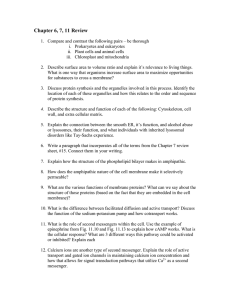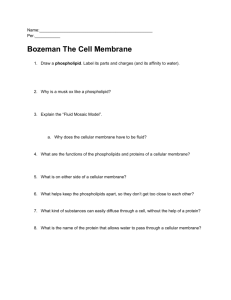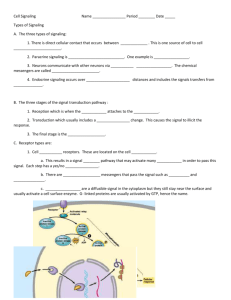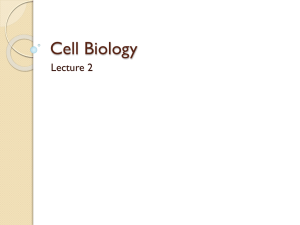AP Biology: Cellular Structure, Transport & Communication Test Review
advertisement
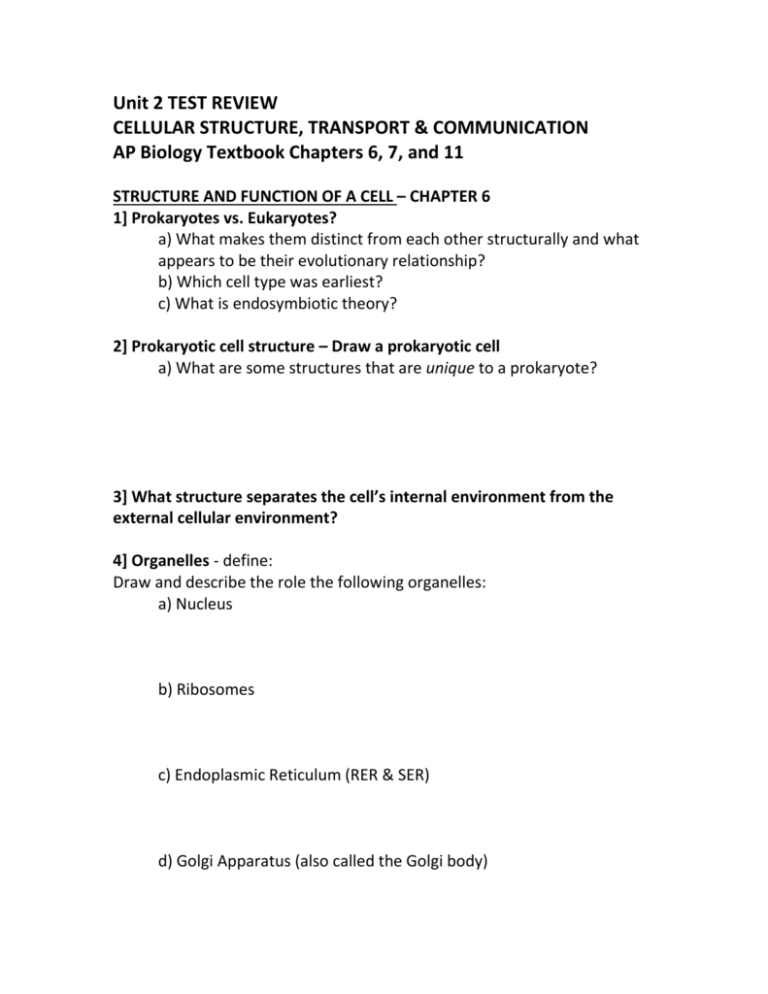
Unit 2 TEST REVIEW CELLULAR STRUCTURE, TRANSPORT & COMMUNICATION AP Biology Textbook Chapters 6, 7, and 11 STRUCTURE AND FUNCTION OF A CELL – CHAPTER 6 1] Prokaryotes vs. Eukaryotes? a) What makes them distinct from each other structurally and what appears to be their evolutionary relationship? b) Which cell type was earliest? c) What is endosymbiotic theory? 2] Prokaryotic cell structure – Draw a prokaryotic cell a) What are some structures that are unique to a prokaryote? 3] What structure separates the cell’s internal environment from the external cellular environment? 4] Organelles - define: Draw and describe the role the following organelles: a) Nucleus b) Ribosomes c) Endoplasmic Reticulum (RER & SER) d) Golgi Apparatus (also called the Golgi body) e) Lysosomes f) Peroxisomes g) Mitochondria h) Chloroplasts i) Central vacuole in plants j) Cytoskeletal components k) Cytoplasm l) Flagella 5] Cell Size - Why are cells as small as they are? What are the functional efficiencies? MEMBRANE STRUCTURE AND FUNCTION – CHAPTER 7 6] What cellular structure separates the cell’s internal environment from its external environment? a) What is the basic structure of the cell’s membrane? Draw, label and describe. b) Why is its structure described as a fluid mosaic model? c) What are some of the characteristics of the membrane that support its functional role in the cell. 7] Membrane proteins provide what roles in the cellular membrane (p.128)? 8] What is the role of membrane carbohydrate structures? 9] Why is the membrane described as selectively or semi-permeable? What types of molecules can traverse the membrane with ease – why? MOVEMENT OF SUBSTANCES = TRANSPORT PASSIVE TRANSPORT 10] What is diffusion? 11] What is osmosis? a) Draw and define hypertonic, isotonic and hypotonic solutions and their effects on cells 12] What is facilitated diffusion? Provide some examples of substances that use facilitated diffusion. ACTIVE TRANSPORT 13] What two things make active transport different from passive transport? 14] Briefly describe the Na+ /K+ ion pump. 15] Exocytosis, why do cells need to do this? 16] Endocytosis, why do cells need to do this? a) Phagocytosis, define b) Pinocytosis, define CELL-TO-CELL COMMUNICATION – CHAPTER 11 17] Why is cell-to-cell communication particularly important in multicellular organisms? 18] Single-celled organisms also communicate – give one example of this process from the ppt. and your text. 19] Several types of cell signaling occur – define each, provide an example: a) Direct contact with neighboring cells (gap junctions & plasmodesmata) b) Synaptic signaling c) Paracrine signaling d) Endocrine signaling 20] What are the three stages of cell signaling as determined by Sutherland and his colleagues at Vanderbilt? 21] What is a ligand? Why is it also referred to as a “first messenger.” 22] What is a second messenger? What are some examples of molecules that serve in this role? 23] What is a signaling cascade? 24] Major signaling pathways: a) Gated ion receptors b) G-protein Coupled receptors c) Protein Kinase receptors, [why can kinases amplify signals?] d) Intracellular receptors
